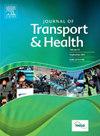Exploring risky driving behaviours among bus drivers in Hanoi, Vietnam using an extended Job Demands-Resources framework
IF 3.2
3区 工程技术
Q2 PUBLIC, ENVIRONMENTAL & OCCUPATIONAL HEALTH
引用次数: 0
Abstract
Introduction
Despite a large body of research on bus safety, scant attention has been given to quantify the factors that lead to unsafe driving behaviours in lower-middle income countries. To address this gap, we empirically investigate the determinants of unsafe behaviours among bus drivers in Vietnam using an extended Job Demands-Resources (JD-R) framework.
Methods
Our study utilized the Partial Least Squares Structural Equation Modelling (PLS-SEM) method to analyse data gathered from 1020 bus drivers across the Hanoi bus network in March 2024.
Results
The results showed that that unsafe driving behaviours were attributable to job demands, personal demands, and job burnout, whereas perceived crash risk and job resources contributed to preventing these behaviours. Job demands were the most decisive risk factor, confirming the stressful, hectic, and strenuous nature of occupational bus driving. While mindfulness did not have a direct effect on unsafe behaviours, it was found to moderate the relationship between job demands and risky behaviours. Specifically, the positive relationship was weaker for more mindful drivers. Additionally, control variables played a key role in predicting risky behaviours, as older and better-educated drivers operating on non-urban routes tended to drive more safely.
Conclusions
Reducing job demands by accounting for working condition constraints when creating schedules is critical to improving bus safety. Increasing bus drivers' perception of collision risks, offering more job resources, and mindfulness training should receive greater attention from practitioners and managers. Further research on factors influencing other unsafe behaviours (e.g., lapses and errors) in other settings is needed.
使用扩展的工作需求-资源框架探索越南河内公交车司机的危险驾驶行为
尽管有大量关于公共汽车安全的研究,但很少有人注意量化导致中低收入国家不安全驾驶行为的因素。为了解决这一差距,我们使用扩展的工作需求-资源(JD-R)框架对越南公交车司机不安全行为的决定因素进行了实证研究。方法采用偏最小二乘结构方程建模(PLS-SEM)方法,对2024年3月河内市公交网络1020名公交司机的数据进行分析。结果不安全驾驶行为与工作需求、个人需求和工作倦怠有关,而感知碰撞风险和工作资源对不安全驾驶行为的预防有重要作用。工作需求是最具决定性的风险因素,证实了职业巴士司机的压力、忙碌和艰苦的性质。虽然正念对不安全行为没有直接影响,但它可以调节工作需求和危险行为之间的关系。具体来说,对于更专注的司机来说,这种正相关关系更弱。此外,控制变量在预测危险行为方面发挥了关键作用,因为年龄较大和受教育程度较高的驾驶员在非城市路线上驾驶时往往更安全。结论:在制定时间表时,考虑工作条件的限制来减少工作需求对提高公交车安全性至关重要。提高公交车司机对碰撞风险的感知,提供更多的工作资源,以及正念训练应该得到从业者和管理者的更多关注。需要进一步研究在其他环境中影响其他不安全行为(例如过失和错误)的因素。
本文章由计算机程序翻译,如有差异,请以英文原文为准。
求助全文
约1分钟内获得全文
求助全文

 求助内容:
求助内容: 应助结果提醒方式:
应助结果提醒方式:


